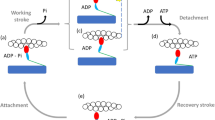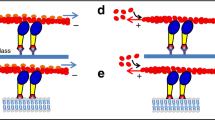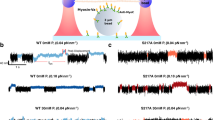Abstract
MYOSINS are a functionally divergent group of mechanochemical enzymes involved in various motile activities in cells1. Despite a high degree of conservation in the amino-acid sequence of the 130K motor domain2,3 (head region) of the molecule, there are large differences in the enzymatic and motile activities (Tables 1 and 2) of myosins from diverse species and cell types. However, the degree of conservation is not uniform throughout the head sequence4; therefore, one reasonable hypothesis is that the functional differences between myosins derive from the poorly conserved areas. The most prominent divergent region occurs at the 50K/20K junction, a region of the molecule sensitive to proteolytic digestion5 and a binding site for actin6–12. We have now constructed chimaeras of this region of myosin by substituting the 9-amino-acid Dictyostelium junction region with those from myosins from other species and find that the actin-activated ATPase correlates well with the activity of the myosin from which the junction region was derived. Our results suggest that this region, likely to be part of the myosin head that interacts directly with actin10,13,14, is important in determining the enzymatic activity of myosin.
This is a preview of subscription content, access via your institution
Access options
Subscribe to this journal
Receive 51 print issues and online access
$199.00 per year
only $3.90 per issue
Buy this article
- Purchase on Springer Link
- Instant access to full article PDF
Prices may be subject to local taxes which are calculated during checkout
Similar content being viewed by others
References
Spudich, J. A. Cell Regul. 1, 1–11 (1989).
Toyoshima, Y. Y. et al. Nature 328, 536–539 (1987).
Kishino, A. & Yanagida, T. Nature 334, 74–76 (1988).
Warrick, H. M. & Spudich, J. A. A. Rev. Cell Biol. 3, 379–421 (1987).
Balint, M., Wolf, I., Tarcsafavli, A., Gergely, J. & Sreter, F. A. Archs Biochem Biophys. 190, 793–799 (1978).
Mornet, D., Pantel, P., Audemard, E. & Kassab, R. Biochem. biophys. Res. Commun. 89, 925–932 (1979).
Yamamoto, K. & Sekine, T. J. Biochem. 86, 1863–1868 (1979).
Botts, J., Muhlrad, A., Takashi, R. & Morales, M. F. Biochemistry 21, 6903–6905 (1982).
Sutoh, K. Biochemistry 22, 1579–1585 (1983).
Yamamoto, K. Biochemistry 28, 5573–5577 (1989).
DasGupta, G. & Reisler, E. J. molec. Biol. 207, 833–836 (1989).
Sutoh, K., Ando, M., Sutoh, K. & Toyoshima, Y. Y. Proc. natn. Acad. Sci. U.S.A. 88, 7711–7714 (1991).
Rayment, I. et al. Science 261, 58–65 (1993).
Schroeder, R. R. et al. Nature 364, 171–174 (1993).
Pope, B., Hoh, J. F. Y. & Weeds, A. FEBS Lett. 118, 205–208 (1980).
Schwartz, K. et al. J. molec. cell. Cardiol. 13, 1071–1075 (1981).
McNally, E. M., Kraft, R., Bravo-Zehnder, M., Taylor, D. A. & Leinwand, L. A. J. molec. Biol. 210, 665–671 (1989).
Knecht, D. A. & Loomis, W. F. Science 236, 1081–1086 (1987).
De Lozanne, A. & Spudich, J. A. Science 236, 1086–1091 (1987).
Barany, M. J. gen. Physiol. 50 (suppl.), 197–218 (1967).
Lymn, R. W. & Taylor, E. W. Biochemistry 10, 4617–4624 (1971).
Stein, L. A., Schwarz, R. P. Jr, Chock, P. B. & Eisenberg, E. Biochemistry 18, 3895–3909 (1979).
Rosenfeld, S. S. & Taylor, E. W. J. biol. Chem. 10, 11920–11929 (1984).
Uyeda, T. Q. P., Kron, S. J. & Spudich, J. A. J. molec. Biol. 214, 699–710 (1990).
White, H. D., Belknap, B. & Jiang, W. J. biol. Chem. 268, 10039–10045 (1993).
Shimizu, T. et al. J. Cell Biol. 112, 1189–1197 (1991).
Sellers, J. R., Eisenberg, E. & Adelstein, R. S. J. biol. Chem. 257, 13880–13883 (1982).
Warshaw, H. M., Derosiers, J. M., Work, S. S. & Trybus, K. M. J. Cell Biol. 111, 453–463 (1990).
Warshaw, D., Peterson, J. & Alpert, N. Biophys. J. 59, 186a (1991).
Sussman, M. in Dictyostelium Discoideum: Molecular Approaches to Cell Biology (ed.Spudich, J. A.) 9–29 (Academic, Orlando, 1987).
Author information
Authors and Affiliations
Rights and permissions
About this article
Cite this article
Uyeda, T., Ruppel, K. & Spudich, J. Enzymatic activities correlate with chimaeric substitutions at the actin-binding face of myosin. Nature 368, 567–569 (1994). https://doi.org/10.1038/368567a0
Received:
Accepted:
Issue Date:
DOI: https://doi.org/10.1038/368567a0
This article is cited by
-
Disease mutations in striated muscle myosins
Biophysical Reviews (2020)
-
Cryo-EM structure of a human cytoplasmic actomyosin complex at near-atomic resolution
Nature (2016)
-
The path to visualization of walking myosin V by high-speed atomic force microscopy
Biophysical Reviews (2014)
-
Erratum to: Identification of functional differences between recombinant human α and β cardiac myosin motors
Cellular and Molecular Life Sciences (2012)
-
Identification of functional differences between recombinant human α and β cardiac myosin motors
Cellular and Molecular Life Sciences (2012)
Comments
By submitting a comment you agree to abide by our Terms and Community Guidelines. If you find something abusive or that does not comply with our terms or guidelines please flag it as inappropriate.



